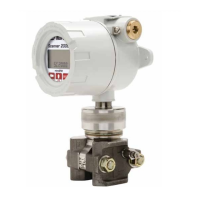33
Scanner
®
2000 microEFM Section 2
Measuring Natural Gas via a Differential Pressure Meter
Note This section contains installation guidelines for orice and cone meters. If installing the Scanner 2000
with an averaging pitot tube meter, refer to manufacturer instructions for installation.
Best Practices for Orice and Cone Meter Installation
To ensure measurement accuracy, ensure that the meter run complies with the following AGA-3 and ISO 5167
guidelines, as applicable:
• Do not place unit near vents or bleed holes that discharge corrosive vapors or gases.
• Consider the orientation of the meter run when determining the best position for mounting the Scanner
2000.
– If the Scanner 2000 is mounted to a horizontal pipeline, make sure process connections are at the top
of the line, and mount the Scanner 2000 above the pressure connections at the pipe.
– If the Scanner 2000 is mounted to a vertical pipeline, install the sensor above the differential pressure
source connections, or install a condensate (drip) pot to prevent the accumulation of liquid in inter-
connecting tubes. Slope all tubing upward at least 1-inch/linear foot to avoid liquid entrapment.
• Mount the Scanner 2000 as near level as possible such that the operator has a clear view of the LCD, and
can access the keypad easily when the enclosure cover is removed. The location should be as free from
vibration as possible.
• Make sure the high port of the sensor (marked “H”) is connected to the upstream side of the meter run.
• Flow should remain subsonic throughout the measuring section and should be single phase.
• Pipe diameters (D) should be between 2 in. (50 mm) and 39 in. (1000 mm) per ISO 5167; or greater than
2 in. (50 mm) per AGA-3.
• Pipe Reynolds numbers must be above 5000.
• d (orice diameter) must be greater than or equal to 0.45 in. (11.5 mm).
• β (diameter ratio) must be greater than or equal to 0.1 and less than or equal to 0.75.
• Gauge lines should be of uniform internal diameter and constructed of material compatible with the uid
being measured. For most applications, the bore should be no smaller than ¼ in. (6 mm) and preferably,
3/8 in. (10 mm) in diameter. The internal diameter should not exceed 1 in. (25 mm). If high-temperature
uids are likely to be encountered, make sure the measuring tube used is rated for the anticipated tem-
perature range.
• Gauge line length should be minimized to help prevent pulsation-induced errors.
• Gauge lines should slope downward to the meter at a minimum of one inch per foot.
• If gauge lines must slope in more than one direction, do not allow more than one bend and install a liquid
or gas trap, as applicable. A liquid trap should be installed at the lowest point in a gas service installation.
• Gauge lines should be supported to prevent sag and vibration.
• Where pulsation is anticipated, full-port manifold valves with a nominal internal diameter consistent with
the gauge lines are recommended.

